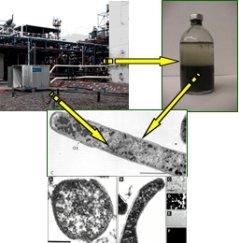Thesis subject
Characterization of 1,2-dichloroethane (1,2-DCA) dechlorination in enrichment cultures from an industrial location
Providing proof of in situ (bio)degradation of pollutants is a classical problem in environmental biogeochemistry.
Lines of evidence include, a.o:
- the establishment of conditions favoring (bio)degradation (pH, redox, …);
- laboratory proof of (bio)degradation under the conditions at the site and possibly the identification of appropriate microorganisms at the site;
- the identification of transformation products and possibly the application of compound Specific Stable Isotope Analysis (CSIA). CSIA is a quickly developing technology to obtain proof for the in situ biodegradation of organic pollutants. It is making use of the fact that bonds involving light istopes (e.g. 12C) react a little bit faster than bonds involving heavy istopes (e.g. 13C). As a result a compound gets enriched in the heavier isotope during its (bio)degradation, so-called fractionation.

We are currently involved in a study of the (bio)degradation of 1,2-dichloroethane (1,2-DCA) at an industrial site in The Netherlands. 1,2-DCA is a precursor in the production of PVC (polyvinylchloride) and an important chemical intermediate in other processes as well, which has led to widespread groundwater contamination due to leakage and improper disposal. This work involves the study of 1,2-DCA (bio)transformation at an industrial site in the Netherlands under various redox conditions ranging from aerobic to methanogenic and sulfate reducing. If possible, you will be involved in the field work at the site. The enrichment cultures will be set up with the site material and 1,2-DCA (bio)transformation will be monitored using gas chromatography analysis. Microbial community of the degrading microcosms will be studied using 16S rRNA gene profiling. CSIA will be used to differentiate between different degradative mechanisms. We will primarily look at 13C/12C fractionation (to be measured in Leipzig) and test whether we are also to able analyze 37Cl/35Cl ratios. The obtained results will be compared to data from parallel studies using available enrichments and a pure culture of the model 1,2-DCA dechlorinating bacterium Desulfitobacterium dichloroeliminans.

We aim to understand the degrading microbial communities, degradation pathways/genes and kinetics with a combination of a molecular and analytical approach. The final aim is to obtain supporting knowledge for the design of 1,2-DCA (bio)remediation strategies at the industrial site.
Start: as soon as possible, open for B.Sc. and M.Sc. students
Advisors: Dr. Tom Bosma, Dr. Siavash Ashtagi
Contact: Tom Bosma, tom1.bosma@wur.nl